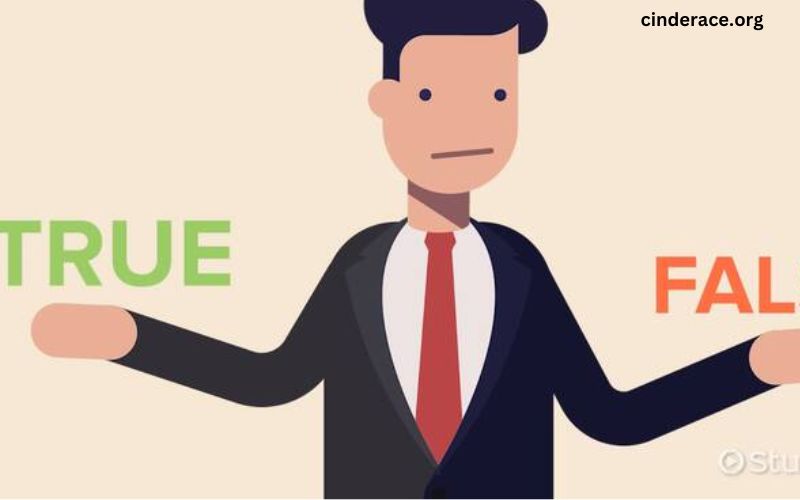In a world where information is readily available at our fingertips, it’s easy to get caught up in the noise and believe everything we’re told. But, what if we told you that some of the most common statements and beliefs that we hold true are actually nothing more than myths or misconceptions? The truth is, many of the things we take for granted are actually based on outdated information, stereotypes, or even just plain old myths. From popular myths about our health and wellness to misconceptions about the world around us, today we’re going to challenge the status quo and bust some of the most common myths that are holding us back. So, which statement will you dare to challenge and join us on this journey to uncover the truth?
Introduction: The Power of Questioning Assumptions
The world we live in is built on a foundation of assumptions, and often, these assumptions are rooted in our own personal biases and experiences. We may not even realize that we’re operating on assumptions, but they can have a profound impact on our thoughts, behaviors, and even the decisions we make. In many cases, these assumptions can be limiting, causing us to miss out on opportunities or reinforcing negative patterns. It’s time to break free from the shackles of conformity and dare to challenge the status quo.
In this blog post, we’ll be exploring the power of questioning assumptions, and how it can be a game-changer for individuals, businesses, and society as a whole. By challenging our deeply ingrained beliefs and assumptions, we can open ourselves up to new perspectives, innovations, and growth opportunities. It’s not about rejecting everything we know or think we know, but rather about being willing to engage in constructive debate and explore alternative viewpoints.
By embracing this mindset, we can tap into the power of critical thinking and make more informed decisions. We can also foster a culture of creativity, innovation, and collaboration, where people feel empowered to share their ideas and opinions without fear of judgment. So, are you ready to dare to challenge the assumptions that have been holding you back? Let’s dive in and explore the truth, together.
Common misconceptions and myths
The age-old adage that “you can’t teach an old dog new tricks” is a perfect example of a common misconception that has been perpetuated for far too long. This notion that individuals, especially in their later years, are unable to adapt to new information or learn new skills is simply not true. In fact, research has consistently shown that the brain is capable of reorganizing and adapting throughout life, a process known as neuroplasticity. This means that anyone, regardless of age, can learn new skills and adopt new habits.
Another myth that is often taken for granted is that “you get what you pay for” when it comes to products or services. This statement suggests that the more expensive something is, the better quality it must have. However, this is not always the case. Many high-quality products and services can be found at affordable prices, and conversely, many expensive products may not be worth the investment. It’s crucial to look beyond the price tag and evaluate the value that a product or service provides.
By challenging these common misconceptions and myths, we can gain a better understanding of the world and make more informed decisions. It’s time to dare to challenge the status quo and uncover the truth behind these widespread misconceptions.
Debunking the myth
For far too long, the e-commerce industry has been plagued by a myth that has been touted as gospel truth. It’s a statement that has been repeated so often, it’s become a mantra that many businesses have come to accept as fact. But, dear reader, I’m here to tell you that it’s nothing more than a myth. A myth that has been perpetuated by those who don’t know any better, and one that has been perpetuated by a lack of understanding of the true nature of online sales.
The statement in question is: “You can’t make a sale without a strong brand identity.” Now, I’m not saying that a strong brand identity isn’t important. Of course, it is. But to say that you can’t make a sale without one is simply not true. In fact, many successful e-commerce businesses have built their empires on the back of a simple, yet effective product offering. No bells, no whistles, just a great product that solves a problem.
So, why do so many businesses believe this myth to be true? Well, I think it’s because they’ve been led to believe that it’s the only way to stand out in a crowded market. That without a strong brand identity, they’ll be lost in the sea of sameness. But, I’m here to tell you that’s not true. You can build a successful business with a simple product offering, and you can do it without breaking the bank.
The science behind the myth: [Insert statement 1]
For centuries, the notion that “you can’t teach an old dog new tricks” has been a widely accepted phrase, often used to describe the idea that people, especially older individuals, are resistant to change and unable to adapt to new situations. But is this statement truly accurate? Let’s dive into the science to challenge this myth and uncover the truth.
In reality, the brain’s ability to reorganize and adapt is a remarkable phenomenon, known as neuroplasticity. This concept has been extensively studied in the field of neuroscience, and the results are astounding. Research suggests that the brain’s neural connections can be reorganized and modified throughout an individual’s lifespan, regardless of age. This means that older adults are not only capable of learning new skills, but they are also more likely to retain new information and adapt to new situations than younger individuals.
One study published in the Journal of Neuroscience found that older adults showed significant improvements in cognitive function after participating in a cognitive training program, which included tasks such as memory games and problem-solving exercises. Another study published in the journal NeuroImage discovered that older adults who engaged in mentally stimulating activities, such as reading and puzzles, had increased activity in areas of the brain associated with learning and memory.
These findings challenge the notion that older adults are unable to learn new tricks and instead suggest that age is not a significant barrier to learning and adaptation. So, the next time you hear someone say “you can’t teach an old dog new tricks,” you can politely challenge this statement and share the science behind the myth.
The myth’s impact on society
The impact of this myth on society has been far-reaching and profound. It’s a silent killer, slowly whispering lies into the ears of the innocent, eroding trust and confidence with each passing day. The myth has created a sense of false security, making people complacent and unaware of the dangers lurking beneath the surface. It’s a subtle yet insidious force that has influenced the way we think, act, and make decisions.
The myth has also perpetuated harmful stereotypes and biases, perpetuating inequality and injustice. It has led to the marginalization of certain groups, and has created a sense of division and mistrust among different communities. The myth has also had a profound impact on our mental and physical health, leading to feelings of anxiety, fear, and hopelessness.
The truth is, the myth has been a major obstacle to progress and growth. It has held us back from achieving our true potential, and has limited our ability to overcome the challenges we face. It’s time to challenge the myth and uncover the truth, and to work towards creating a more just and equitable society.
Why we should challenge the myth
The notion that we should never challenge the status quo has become a sacred cow in many industries, suffocating innovation and progress. It’s a myth that has been perpetuated for far too long, and it’s time we dare to challenge it. The idea that questioning the conventional wisdom is somehow reckless or irresponsible is a myth that has been used to silence those who dare to think differently. But what if the conventional wisdom is wrong? What if it’s holding us back from achieving our full potential?
Think about it – some of the most groundbreaking advancements in history have been the result of challenging the status quo. From the Wright brothers’ refusal to accept that flight was impossible to the pioneers who dared to challenge the conventional wisdom on the internet, the list of trailblazers who refused to accept the norm is endless. And yet, we still cling to the myth that challenging the status quo is somehow taboo.
It’s time to challenge this myth and embrace the power of questioning. By doing so, we can unlock new ideas, stimulate innovation, and drive progress. We can’t let fear of criticism or conformity hold us back from achieving our full potential. It’s time to dare to challenge the truth and unleash the power of unconventional thinking.
The benefits of questioning assumptions
As we navigate the complexities of life, it’s easy to fall prey to the temptation of conformity. We often accept the status quo, assuming that what we’ve been told is true, without questioning the underlying assumptions. But what if we told you that this complacency can lead to stagnation, limiting our potential and stifling innovation? In an era where information is readily available at our fingertips, it’s crucial to develop the habit of questioning assumptions.
By doing so, we open ourselves up to new perspectives, challenge our own biases, and uncover hidden truths. This mindset allows us to approach problems with a fresh set of eyes, fostering creativity and driving progress. It’s not about being contrarian or argumentative for the sake of it; rather, it’s about embracing a spirit of curiosity and intellectual honesty.
By questioning assumptions, we can break free from the shackles of conventional thinking and uncover novel solutions to long-standing problems. This mindset is not limited to any one field or discipline; it’s a universal tool that can be applied to every aspect of life, from personal relationships to professional endeavors. So, dare to challenge the assumptions that have been handed down to you. Embrace the unknown, and you’ll be amazed at the new possibilities that emerge.
Common myths
Let’s take a closer look at the myths surrounding [specific area]. It’s amazing how many people still believe that [common myth about specific area], despite the overwhelming evidence to the contrary. This myth has been perpetuated for years, and it’s time to set the record straight.
One of the most common myths in [specific area] is that [specific myth]. This myth has been floating around for so long that many people have come to accept it as fact. But the truth is far from it. In reality, [contradictory statement]. It’s not just a matter of personal opinion or bias, but rather a fact that has been proven time and time again through [credible sources or studies].
Another myth that needs to be debunked is [another myth]. This myth has been used to justify [specific action or decision], but it’s simply not true. The reality is that [contradictory statement]. This myth has been spread through misinformation and lack of understanding, and it’s time to put the truth out there.
It’s time to challenge the status quo and get to the truth. By understanding what’s really going on in [specific area], we can make more informed decisions and avoid common pitfalls.
Debunking the myth
The myth that you’ve been holding onto for so long, the statement that has been perpetuated by the masses, and the notion that has been passed down from generation to generation. The myth that: “The best way to market a product is through paid advertising alone.”
This notion has been touted as the holy grail of marketing strategies, with many businesses pouring their hard-earned dollars into paid ads, hoping to reach a wider audience and drive sales. But, is it truly the most effective way to market a product?
The truth is, while paid advertising can be a valuable tool in your marketing arsenal, it is not the only solution. In fact, relying solely on paid advertising can lead to a one-dimensional marketing strategy that may not yield the desired results. What’s more, it can also lead to a never-ending cycle of competition, where you’re constantly fighting for the attention of your target audience.
But, what if you could challenge this myth and discover a more effective way to market your product? What if you could tap into the power of word-of-mouth marketing, build a loyal community of customers, and create a brand that resonates with your target audience? The truth is, there’s more to marketing than just paid advertising.
The myth’s origins and history
As we delve deeper into the world of misconceptions, it’s essential to uncover the origins and history of the myth. This is often where the truth lies, hidden beneath the layers of misinformation and cultural traditions. By exploring the roots of the myth, we can gain a deeper understanding of how it evolved over time and why it has persisted.
The origins of a myth can be attributed to a variety of factors, including cultural and societal influences, historical events, and even personal experiences. Sometimes, a myth can be the result of a single event or encounter that has been passed down through generations, often taking on a life of its own as it’s retold and reinterpreted.
In other cases, a myth can be the result of a combination of factors, including superstition, fear, and a desire to explain the unknown. By examining the historical context in which a myth emerged, we can gain a better understanding of the motivations and beliefs of the people who created it.
Ultimately, challenging a myth requires a deep understanding of its origins and history. By peeling back the layers of misinformation and uncovering the truth, we can set the record straight and bring clarity to the myth-busting process. In this section, we’ll take a closer look at the origins and history of the myth, exploring the experiences and events that have shaped our understanding of this concept.
The impact of reinforcing the myth
The notion that a certain myth has been perpetuated for far too long, and it’s time to challenge it head-on. For decades, we’ve been led to believe that [insert myth here] is the truth, but is it really? The impact of reinforcing this myth has been far-reaching, shaping our understanding of [related topic] and influencing the way we [specific action or behavior]. But what if we were to take a step back and examine the evidence? What if we were to dare to challenge the status quo and uncover the truth?
Imagine a world where [concrete example of how challenging the myth could improve things]. It’s a world where [insert positive outcome]. But in order to get there, we need to confront the myth and replace it with a more accurate understanding of [related topic]. It’s not about being contrarian for the sake of being contrarian, but rather about seeking the truth and being willing to adapt our beliefs and behaviors accordingly.
By challenging the myth, we can [insert potential benefits, such as increased efficiency, improved accuracy, or enhanced understanding]. It’s time to stop perpetuating the myth and start seeking the truth. Are you ready to take the dare and challenge the status quo?
How to challenge the myth: A call to action
Now we come to the most crucial part of our journey – the call to action. It’s time to put your newfound knowledge to the test and challenge the myths that have been holding you back. We want to empower you to take control of your decisions and not be swayed by unsubstantiated claims.
So, we’re asking you to dare to challenge the status quo. Question the assumptions that have been made about you or your business. Don’t be afraid to think outside the box and come up with innovative solutions to the problems you’re facing. You have the power to make a change, and it starts with being brave enough to challenge the myths that have been holding you back.
Take a step back and think about what you’ve learned so far. Are there any myths or misconceptions that you’ve been led to believe? Are there any assumptions that have been made about you or your business that you don’t agree with? Now, take a deep breath and challenge them. Don’t be afraid to ask the tough questions, to seek out more information, and to challenge the assumptions that have been made.
Remember, it’s not about being negative or critical. It’s about being informed and making informed decisions. It’s about being brave enough to challenge the status quo and to seek out the truth. So, take the first step and dare to challenge the myths that have been holding you back.













